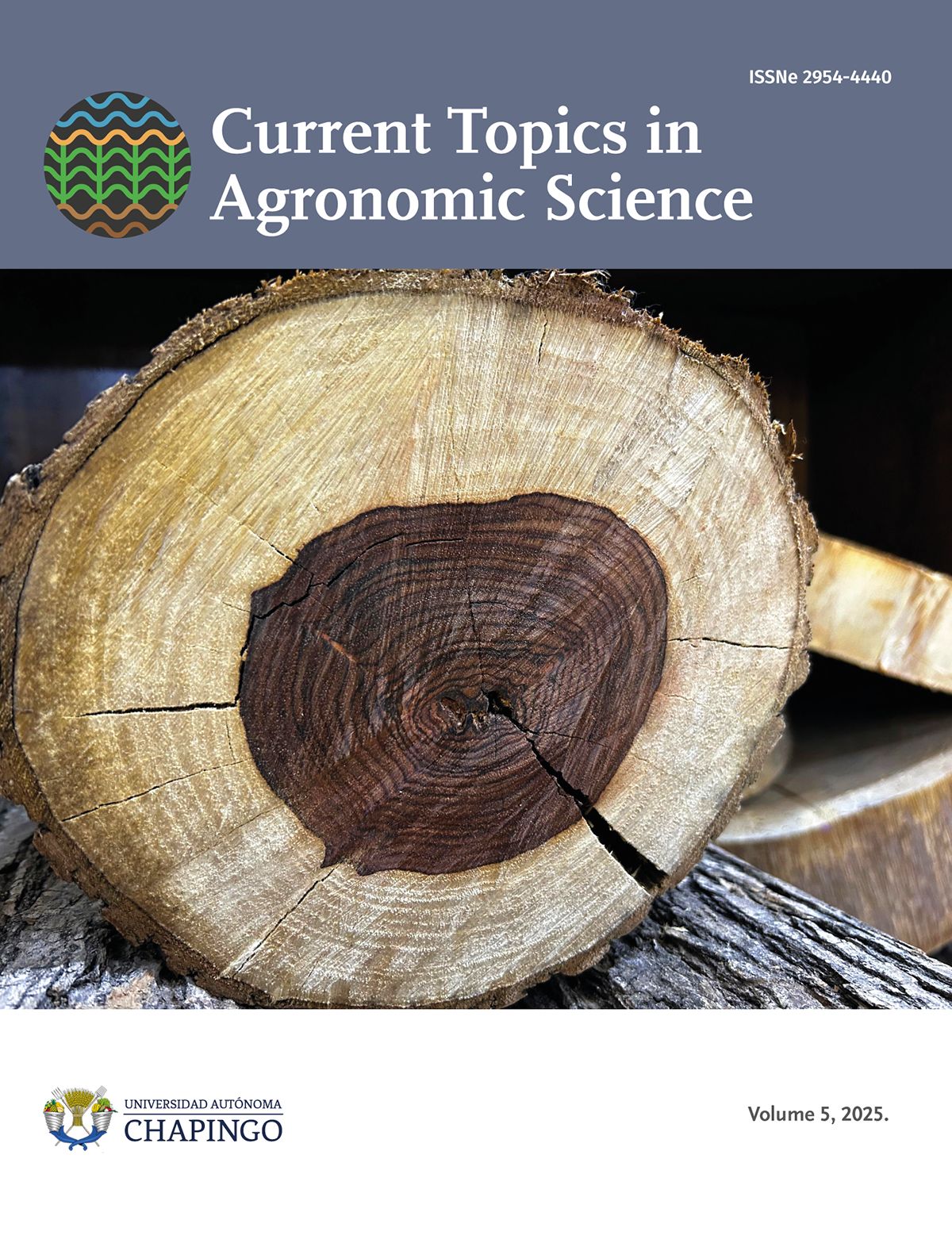Abstract
Zeolites are crystalline, nanoporous minerals with a high capacity for water adsorption and nutrient retention, which can be gradually released into the root zone. These properties make them promising materials for improving nutrient availability and crop productivity. The objective of the present study is to evaluate the effect of zeolite incorporation into the substrate on the development of lettuce (Lactuca sativa L. cv. Maximus) plants. Seeds were sown in polystyrene foam trays and irrigated with Universal Steiner nutrient solution at 25 and 50 % concentrations. After thirty days of sowing, the seedlings were transplanted into 3 L polyethylene bags containing a mixture of tezontle (particles > 0.5 cm) and zeolite at 0, 2, 4 and 6 % (v/v). The addition of zeolite to the substrate reduced plant height and leaf number at the tested doses; additionally, the 6 % treatment decreased the length of the largest leaf compared with the control. The addition of zeolite to the substrate affects lettuce plant development.
References
Ahmed, O. H., Sumalatha, G., & Muhamad, A. N. (2010). Use of zeolite in maize (Zea mays) cultivation on nitrogen, potassium and phosphorus uptake and use efficiency. International Journal of the Physical Sciences, 5(15), 2393-2401.
Bybordi, A., & Ebrahimian, E. (2013). Growth, yield and quality components of canola fertilized with urea and zeolite. Communications in Soil Science and Plant Analysis, 44(19), 2896–2915. https://doi.org/10.1080/00103624.2013.823986
Cabrera-Fajardo, S. R., Medina-Ramírez, A., & Fuentes-Ramírez, R. (2018). Evaluación fitotoxicológica de nanozeolitas. Jóvenes en la Ciencia, 4(1), 1223–1228.
Govindasamy, P., Mahawer, S. K., Sarangi, D., Halli, H. M., Das, T. K., Raj, R., Saini, R. K., Choudhary, R. K., Verma, A. K., Kumar, R., Soni, P. G., Goyal, R. K., Choudhary, M., Kumar, P., & Chandra, A. (2022). The comparison of Canopeo and SamplePoint for measurement of green canopy cover for forage crops in India. MethodsX, 9, 101916. https://doi.org/10.1016/j.mex.2022.101916
Hassan, M. U., Shah, S. T., Basit, A., Hikal, W. M., Khan, M. A., Khan, W., Tkachenko, K. G., Brini, F., & Said-Al Ahl, H. A. H. (2024). Improving wheat yield with zeolite and tillage practices under rain-fed conditions. Land, 13(8), 1248. https://doi.org/10.3390/land13081248
Hazrati, S., Tahmasebi-Sarvestani, Z., Mokhtassi-Bidgoli, A., Modarres-Sanavy, S. A. M., Mohammadi, H., & Nicola, S. (2017). Effects of zeolite and water stress on growth, yield and chemical compositions of Aloe vera L. Agricultural Water Management, 181, 66–72. https://doi.org/10.1016/j.agwat.2016.11.026
Hazrati, S., Khurizadeh, S., & Sadeghi, A. R. (2022). Application of zeolite improves water and nitrogen use efficiency while increasing essential oil yield and quality of Salvia officinalis under water-deficit stress. Saudi Journal of Biological Sciences, 29(3), 1707–1716. https://doi.org/10.1016/j.sjbs.2021.10.059
Kim, M. J., Moon, Y., Tou, J. C., Mou, B., & Waterland, N. L. (2016). Nutritional value, bioactive compounds and health benefits of lettuce (Lactuca sativa L.). Journal of Food Composition and Analysis, 49, 19-34. https://doi.org/10.1016/j.jfca.2016.03.004
Lahori, A. H., Mierzwa-Hersztek, M., Demiraj, E., Sajjad, R. U., Ali, I., Shehnaz, H., Aziz, A., Zuberi, M. H., Pirzada, A. M., Hassan, K., & Zhang, Z. (2020). Direct and residual impacts of zeolite on the remediation of harmful elements in multiple contaminated soils using cabbage in rotation with corn. Chemosphere, 250, 126317. https://doi.org/10.1016/j.chemosphere.2020.126317
Li, Z., Zhang, Y., & Li, Y. (2013). Zeolite as slow release fertilizer on spinach yields and quality in a greenhouse test. Journal of Plant Nutrition, 36(10), 1496–1505. https://doi.org/10.1080/01904167.2013.790429
Maestre-Valero, J. F., Martin-Gorriz, B., Soto-García, M., Martinez-Mate, M. A., & Martinez- Alvarez, V. (2018). Producing lettuce in soil-based or in soilless outdoor systems: Which is more economically profitable? Agricultural Water Management, 206, 48–55. https://doi.org/10.1016/j.agwat.2018.04.030
Mahmoud, A. W. M., Rashad, H. M., Esmail, S. E. A., Alsamadany, H., & Abdeldaym, E. A. (2024). A tool to enhance drought tolerance in coriander plants for improving growth and productivity. Plants, 13(3), 455. https://doi.org/10.3390/plants13030455
Ozbahce, A., Tari, A. F., Gönülal, E., Simsekli, N., & Padem, H. (2014). The effect of zeolite applications on yield components and nutrient uptake of common bean under water stress. Archives of Agronomy and Soil Science, 61(5), 615–626. https://doi.org/10.1080/03650340.2014.946021
Rahmany-Samani, A., Ghobadinia, M., Sayyed-Hassan, T., Nourmahnad, N., & Danesh-Shahraki, A. (2023). The effect of irrigation and zeolite management on the reduction of cadmium accumulation in rice. Agricultural Water Management, 287, 108448. https://doi.org/10.1016/j.agwat.2023.108448
Sangeetha, C., & Baskar, P. (2016). Zeolite and its potential uses in agriculture: A critical review. Agricultural Reviews, 37(2), 101–108. https://doi.org/10.18805/ar.v0iof.9627
Sharma, P. C. D., Rahman, M. M., Mollah, M. A. H., & Islam, M. S. (2009). Influence of method and date of planting on the production of lettuce. Bangladesh Journal of Agricultural Research, 34(1), 75–80. https://doi.org/10.3329/bjar.v34i1.5747
Smedt, C. D., Steppe, K., & Spanoghe, P. (2017). Beneficial effects of zeolites on plant photosynthesis. Advanced Material Science, 2(1), 1–6. https://doi.org/10.15761/AMS.1000115
Steiner, A. A. (1984). The universal nutrient solution. In Proceedings of the Sixth International Congress on Soilless Culture (pp. 633–650). Wageningen, The Netherlands.
Szatanik-Kloc, A., Szerement, J., Adamczuk, A., & Józefaciuk, G. (2021). Effect of low zeolite doses on plants and soil physicochemical properties. Materials, 14(10), 2617. https://doi.org/10.3390/ma14102617
Tanaka, F. C., Yonezawa, U. G., de Moura, M. R., & Aouada, G. A. (2023). Obtention, characterization, and herbicide diquat carrier/release properties by nanocomposite hydrogels based on polysaccharides and zeolite for future use in agriculture. Environmental Nanotechnology, Monitoring & Management, 20, 100880. https://doi.org/10.1016/j.enmm.2023.100880
Zeinalipour, N., & Saadati, S. (2024). Physiological and biochemical response of strawberry cv. Diamond to Nano zeolite soil application and cinnamic acid foliar application. Scientific Reports, 14(1), 28908. https://doi.org/10.1038/s41598-024-76419-5

This work is licensed under a Creative Commons Attribution-NonCommercial-ShareAlike 4.0 International License.
Copyright (c) 2025 Current Topics in Agronomic Science



